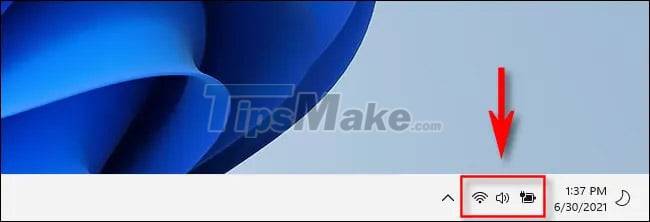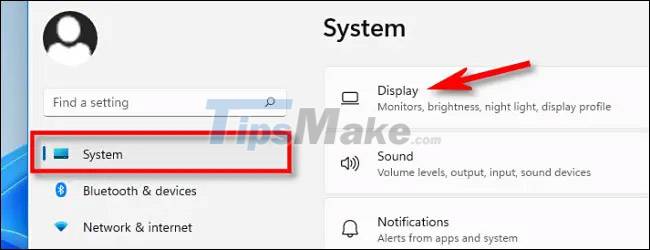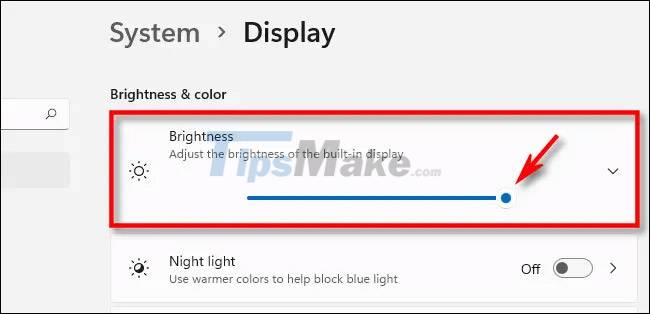Steps to change screen brightness on Windows 11
With just a few simple clicks in the Settings app, you can adjust the screen brightness whenever you want. Here's how to do it.
Change screen brightness using Quick Settings menu
Quick Settings is an extremely useful menu on Windows 11, that allows you to intervene and quickly customize some basic settings aspects of the system, without accessing the Settings application as usual.
First, click the Quick Settings button on your taskbar, which is a hidden button located in the area of WiFi, speaker, and battery icons in the far-right corner of the screen.

When the Quick Settings menu interface pops up, look for the brightness slider, with the sun icon next to it. Click (or tap) and drag the circle on the brightness slider to increase or decrease the screen's brightness respectively. Release your hand when the appropriate brightness level is selected.

If you pay attention, you will see the sun icon grow larger or smaller depending on the brightness set on the slider. Once you've chosen the screen brightness you want, you can close the Quick Settings menu by clicking anywhere outside the menu, or tapping the WiFi, speaker, and battery icon area on the taskbar again.
Change the screen brightness in the Settings app
You can also change the brightness of the built-in display using the familiar Settings Windows app.
First, open the Windows Settings application by pressing the Windows + i key combination. Or you can also right-click the Start button on the taskbar and select 'Settings' from the pop-up menu.
In the Settings window that opens, click the 'System' item in the sidebar, then select 'Display'.

In the System Display settings, scroll down to the 'Brightness & Color' section. In the 'Brightness' section, use the slider to increase or decrease the screen's brightness.

When done, close Settings. Whenever you need to adjust the brightness again, go to Settings > System > Display again or use the Quick Settings menu above.
Screen brightness slider not available
In case you are not using a device with a built-in display (such as a laptop, tablet, or all-in-one), the screen brightness slider in Quick Settings may not be available (toggle to gray). At this point, you'll need to use the display's physical controls to change the brightness. Consult the manufacturer's user manual or support website to learn how to do that. Good luck!
You should read it
- These software change the brightness, contrast the most effective computer screen
- Top 5 best screen brightness control apps on Android
- How to turn off the automatic screen brightness change feature (Auto Brightness) on Windows 11
- Adjust screen brightness of Windows 7 on PC, laptop
- What is Nit when it comes to screen brightness?
- How to adjust the screen brightness of Windows 10 on the desktop
- Fix the error of not adjusting screen brightness on Windows 10
- What is Nit screen brightness?
May be interested
- Tutorial 4 ways to adjust the screen brightness of Windows 10
 in this article, you will know how to adjust the screen brightness of windows 10 to get the right screen brightness for eye protection as well as extend the screen life of pc, laptop and laptop battery.
in this article, you will know how to adjust the screen brightness of windows 10 to get the right screen brightness for eye protection as well as extend the screen life of pc, laptop and laptop battery. - What is Nit when it comes to screen brightness?
 nit is a unit of measurement for luminance or visible light intensity, one nit is equal to one candela per square meter. nits are used to describe the brightness of computer screens, such as lcd and crt screens.
nit is a unit of measurement for luminance or visible light intensity, one nit is equal to one candela per square meter. nits are used to describe the brightness of computer screens, such as lcd and crt screens. - What is Nit screen brightness?
 if you're looking to buy a monitor, you've probably heard of a nit unit, which indicates how much light per square meter the monitor can emit. nit is important if you plan to use your device outdoors often.
if you're looking to buy a monitor, you've probably heard of a nit unit, which indicates how much light per square meter the monitor can emit. nit is important if you plan to use your device outdoors often. - Error not adjusting screen brightness after upgrading Windows 8.1
 after upgrading to windows 8.1, many users encounter errors that cannot adjust screen brightness. although every method has been applied to fix the error, it still fails. so how to fix this error, please refer to the following article of network administrator.
after upgrading to windows 8.1, many users encounter errors that cannot adjust screen brightness. although every method has been applied to fix the error, it still fails. so how to fix this error, please refer to the following article of network administrator. - Automatic shutdown increases the screen brightness of Windows 10
 turning off the auto-light feature on windows 10 will help you adjust the brightness according to your preference, without having an annoying flashing light when changing from light to dark and vice versa.
turning off the auto-light feature on windows 10 will help you adjust the brightness according to your preference, without having an annoying flashing light when changing from light to dark and vice versa. - How to adjust the screen brightness on Windows 10 Laptop
 if you just bought a laptop to serve the needs of learning, working, entertainment but do not know how to increase or decrease the brightness on the laptop, in this article, the software tips will guide you all the details. the fastest and most convenient way to adjust screen brightness on computer.
if you just bought a laptop to serve the needs of learning, working, entertainment but do not know how to increase or decrease the brightness on the laptop, in this article, the software tips will guide you all the details. the fastest and most convenient way to adjust screen brightness on computer. - How to bring Night Shift feature to Mac with F.lux
 f.lux is an application that reduces screen brightness on a computer, which is similar to the night shift feature on iphone and ipad devices. when installing f.lux on macos mac, users can optionally adjust the screen color to change the screen brightness.
f.lux is an application that reduces screen brightness on a computer, which is similar to the night shift feature on iphone and ipad devices. when installing f.lux on macos mac, users can optionally adjust the screen color to change the screen brightness. - How to change SDR and HDR light balance in Windows 10
 when connecting an hdr10-capable monitor or tv to a windows 10 pc that supports hdr and wcg colors, you get a brighter, more vibrant picture and more detail than the standard sdr screen.
when connecting an hdr10-capable monitor or tv to a windows 10 pc that supports hdr and wcg colors, you get a brighter, more vibrant picture and more detail than the standard sdr screen. - How to change the indicator position on the Windows 11 screen
 when adjusting volume brightness and airplane mode with keyboard shortcuts, the on-screen indicator appears in the bottom center. here's how to change the indicator position on your windows screen.
when adjusting volume brightness and airplane mode with keyboard shortcuts, the on-screen indicator appears in the bottom center. here's how to change the indicator position on your windows screen. - 15 ways to adjust the brightness of computer and laptop screens
 in this article you will learn 12 ways to adjust windows 10 screen brightness to help get the right screen brightness to protect your eyes as well as extend the life of your pc, laptop screen and laptop battery.
in this article you will learn 12 ways to adjust windows 10 screen brightness to help get the right screen brightness to protect your eyes as well as extend the life of your pc, laptop screen and laptop battery.










 How to compress and decompress files on Windows 11
How to compress and decompress files on Windows 11 Microsoft gives reasons to make Windows 11 faster than Windows 10 on the same computer
Microsoft gives reasons to make Windows 11 faster than Windows 10 on the same computer Ways to turn off Windows 11 PCs
Ways to turn off Windows 11 PCs How to resize virtual keyboard/touch keyboard on Windows 11
How to resize virtual keyboard/touch keyboard on Windows 11 How to create Windows 11 installation USB for computers that do not meet TPM 2.0 hardware
How to create Windows 11 installation USB for computers that do not meet TPM 2.0 hardware An advertisement that Microsoft tried to insert into the system caused a recent Taskbar error on Windows 11
An advertisement that Microsoft tried to insert into the system caused a recent Taskbar error on Windows 11